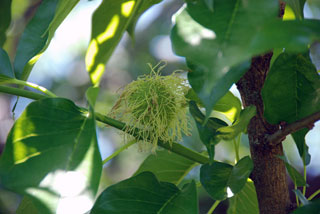OSAGE ORANGE
|
 |
| File Size: 70 KB |
|
|
|
Maclura pomifera (Raf. ) C. K. Schneider
|
| Johnson County, Kansas |
| Height: 20-60 feet |
| Family: Moraceae - Mulberry Family |
| Flowering Period: May, June |
|
| Also Called: | | Hedge-apple, bois d'arc. | | Trunks: | | Short; bark dark orange-brown, shallow furrows, frequently peeling in long, flat strips; branches arching upward; crown low, rounded. | | Twigs: | | Frequently zigzag, greenish-yellow or orange-brown, armed with stout, straight spines, to 1 inch long; buds often paired, larger one reddish-brown; leaf scars half-round or broadly triangular; bundle scars several, arranged in oval. | | Leaves: | | Alternate, simple, deciduous, egg-shaped to elliptic-lanceolate, 1.6 to 4.8 inches long, .8 to 2.4 inches wide, thick, firm; upper surface dark green, shiny; lower surface paler; margins entire; tip long-pointed; base rounded or bluntly tapered; stalk slender, .8 to 2 inches long, grooved on top, usually somewhat pubescent. | | Flowers: | | Male and female flowers occur on separate trees; staminate flowers in dense spherical or oblong clusters .5 to .8 inch in diameter; flowers small, stalked, yellowish-green, hairy; stamens 4; anthers yellow; pistillate flowers in dense spherical heads .6 to 1 inch in diameter, sessile or short-stalked in leaf axils; calyx 4-lobed; styles long, conspicuous, thread-like, yellowish. | | Fruit: | | Autumn; aggregate of many small fruits in orange-like ball, 2 to 6 inches in diameter, pale green, lumpy, wrinkled; fruits small, fleshy, grown together; juice milky, sticky; seeds oval, .3 to .5 inch long, pale brown. | | Habitat: | | Hedge rows, shelter belts, woods, ravines, fence rows, waste places; rich soils. | | Distribution: | | Throughout Kansas | | Origin: | | Native | | Uses: | | Osage orange provides cover for song birds, game birds, and wildlife. Rabbits and squirrels eat the seeds. The Kiowa used the bark of the roots to make a yellow dye and the Comanche, Omaha, Pawnee, and Ponca fashioned bows from the branches. The roots were boiled and the liquid used as a wash for sore eyes. | | Comments: | | Osage orange was often planted in wind breaks. The wood is bright orange, very hard, strong, heavy, coarse-grained, and is highly durable. Limbs and trunks are often used for fence posts. Bois d'arc means "wood of the bow". Maclura honors William McClure, an early geologist. pomifera means "fruit-bearing". |
|
| Osage orange staminate flowers |  | | 45 KB | | Johnson County, Kansas |
| | Osage orange pistillate flowers |  | | 78 KB | | Johnson County, Kansas |
| | Osage orange staminate flowers |  | | 66 KB | | Johnson County, Kansas |
| | Osage orange |  | | 147 KB | | Johnson County, Kansas |
| | Osage orange trunk |  | | 172 KB | | Johnson County, Kansas |
| | Osage orange bark |  | | 160 KB | | Johnson County, Kansas |
| | Osage orange leaves |  | | 61 KB | | Johnson County, Kansas |
| | Osage orange leaves |  | | 70 KB | | Johnson County, Kansas |
| | Osage orange fruit |  | | 98 KB | | Woodson County, Kansas |
| | Osage orange |  | | 143 KB | | Johnson County, Kansas |
| | Osage orange bud and spine |  | | 36 KB | | Geary County, Kansas |
| | Osage orange bud and spine |  | | 30 KB | | Geary County, Kansas |
| | Osage orange bark |  | | 177 KB | | Geary County, Kansas |
| | Osage orange fruit |  | | 131 KB | | Atchison County, Kansas |
| |
|
|
|